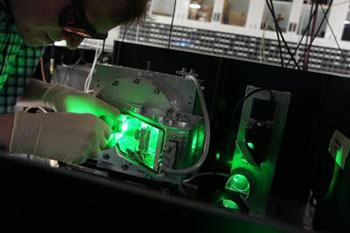
Co-lead author Joseph Heremans adjusts a component of the optical setup. (Credit: Courtesy of Christopher Yale/University of Chicago)
In the quest for workable building-blocks for quantum information processing, atom-scale defects in semiconductors have shown a lot of promise. But the quantum mechanical behavior of electrons in these systems can vary with the material, and tools to characterize that behavior on a range of timescales—let alone control it—have been lacking. Now, a team of U.S. and German scientists has developed a method that uses picosecond pulses of laser light to record and control the orbital and spin dynamics of individual electrons in such systems, on timescales spanning six orders of magnitude (Science, doi: 10.1126/science.1255541).
The researchers—from the University of California, Santa Barbara, and the University of Chicago (U.S.A.) and the University of Konstanz (Germany)—focused on the nitrogen vacancy (NV) center in diamond, a nanoscale defect with potential as a computational and memory element in quantum information systems. After using confocal microscopy to isolate NV centers in a prepared diamond sample, the scientists aimed paired picosecond laser pulses at individual defects, with the time delay between the pulses controlled by an optical delay line. Using a variety of techniques, they then read the spin and orbital state of the electron after the initial and final pulses.
Varying the elapsed time between the pulses enabled the researchers to create “snapshots” of the quantum state’s evolution in the defect, on timescales varying from femtoseconds to nanoseconds. The ability to probe on such short timescales, and over such a wide range, provides a particularly useful view, according to the team, because the numerous, complex interactions of the electron with the material each has its own characteristic timescale.
While the specific work used the diamond NV center as a model, the team stresses that the technique could be used over a range of atomic, molecular, and solid-state quantum systems. And, by making it easier to identify and characterize such systems, the researchers believe the new tool could accelerate the drive toward quantum computing. “Through the application of these ultrafast pulses,” said co-lead author F. Joseph Heremans, “we get a much richer understanding of this quantum beast.”
